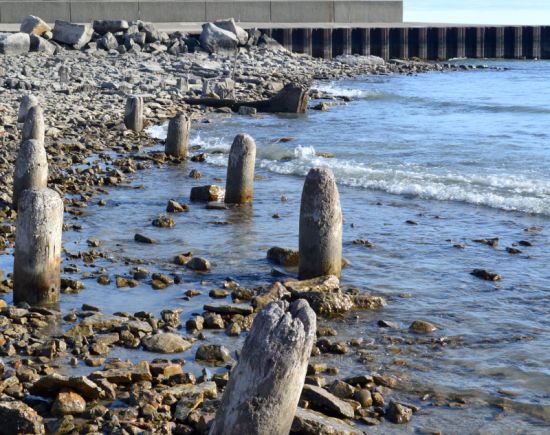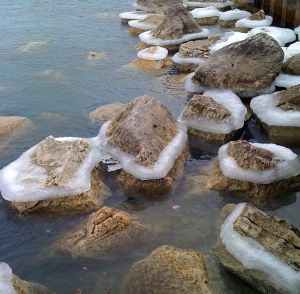

The Great Lakes hold 20 percent of the world's available surface freshwater -- enough to cover the continental United States with 10 feet of water if you turned them upside down. In many places along the lakes, you can stand on one side without seeing the shoreline on the other because they are so huge. It's difficult to remember that you're looking at an inland lake instead of an ocean. The vast lakes seem limitless, but are they?
In December and January, Lake Michigan and Lake Huron, scientifically considered one lake pinched in the middle, set record after record for low water levels. Experts, including those of us at the Shedd Aquarium, expect water levels to continue dropping for the next several months. Locals living across the Great Lakes basin are concerned about future impacts on the region's economy and biodiversity.
Fortunately, we can get some context by referring to a century of standardized data on Great Lakes water levels. We can even approximate water levels for the past 15,000 years, back to when the region was covered by glaciers. After spending 20 years studying fish in the Great Lakes, I can tell you that the water level in Lakes Michigan and Huron are always going up and down from week to week, season to season, year to year, and decade to decade. It is not a stable system and never was.
The real recent concern is the lake level has been below average for several years and shows no signs of increasing. What is driving this unprecedented pattern?
The question is actively debated, but the primary factors influencing lake levels are rain and snowfall, evaporation, the Chicago and St. Clair rivers that flow out of the lake, dredging in the St. Clair River, and the rising and settling of the earth's crust after the melting of the glaciers. The interaction of all these factors is complicated, but I believe there is one standout factor with the most impact over the last decade: evaporation rates.
If you aren't in the field testing and evaluating the lakes on a regular basis as I am, it's hard to appreciate the influence of evaporation because it is essentially invisible. However, massive amounts of water vapor are lost to the atmosphere. Each year, around 22 cubic miles of water evaporate off of Lakes Michigan and Huron. That's enough to cover the city of Chicago with 500 feet of water, or Washington, D.C., with 1,700 feet -- three times the height of the Washington Monument!

What does evaporation have to do with lake levels? The lakes are getting warmer, which increases evaporation. While we welcome the milder, warm winters, the lakes don't. There is less ice cover now, and ice serves an important purpose for the lakes, acting as a protective blanket that keeps water vapor from escaping into the air. Less ice means more water vapor is lost and lake levels decline. Models predict that Lake Michigan and Lake Huron could drop by two or more feet by the end of the century.
This is a lot of liquid for a region whose identity is so closely tied to water -- most notably the boating and shipping community. Cities will have to dredge harbors so boats can get in and out. Lower water means freighters can carry fewer items, necessitating additional trips between ports to move the same amount of goods. That increases operating expenses, and these increased costs are passed onto consumers. Lakefront communities, many of which depend on tourism, may no longer find themselves on the lake. Combined costs of dredging, shipping and tourism will reach hundreds of millions of dollars. It's a domino effect.
There are other local residents impacted: Great Lakes plants and animals. Shedd Aquarium's research and conservation team is assessing potential effects of low lake levels on our native flora and fauna -- and our findings will likely be mixed. Because Lake Michigan reaches 900-foot depths or more, a drop of a couple of feet is unlikely to impact many fishes swimming around the lake. However, we are very concerned about coastal wetlands that thrive in just a few feet of water. The same lake level drop could easily dry up wetlands, which are critical habitats for migrating birds, spawning fishes, and sensitive plants. If the drop happens slowly enough, it is possible that species may have time to migrate to different habitats, but there are no guarantees that they will be successful.
There is always uncertainty when using models to predict the future. The only safe prediction is change. Lake levels will go up and down, as they have in the past. Rivers and streams will erode banks and meander through the countryside. Wind will create and destroy sand dunes. Nature is ever-changing. It is people that have trouble with change. We want stability and are perpetually fighting nature to keep it in its place.
The solution is to focus on incorporating future natural instability into our conservation efforts and civic planning. Restoring a wetland in such a way that it will continue to support migrating birds, spawning fishes, and sensitive plants if water levels rise a couple feet or drop a couple feet is preferable to restoring a wetland based on the assumption that current water levels will not change. Designing a harbor that will accommodate lake level fluctuations of several feet will save time and money in the future.
Instead of fighting nature, we need to figure out better ways to comfortably live alongside its changes.